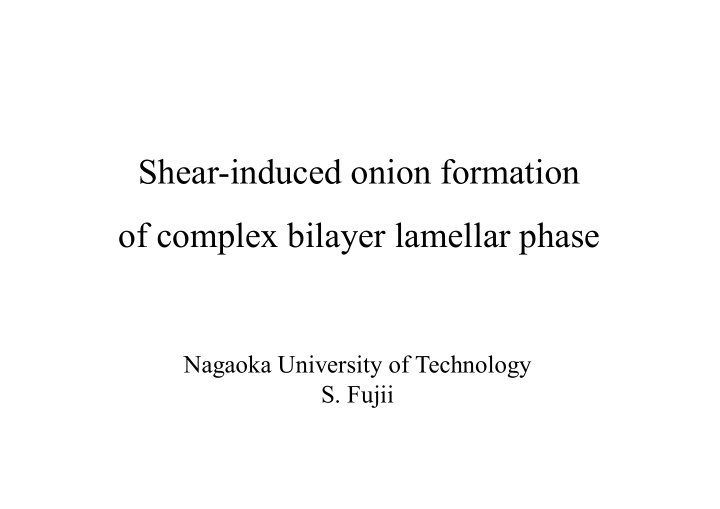



Shear-induced onion formation of complex bilayer lamellar phase Nagaoka University of Technology S. Fujii
Shear induced onion phase Cylinder L α Onion α Buckled L α α SDS / Dodecane / Pentanol / Water System O. Diat, D. Roux, F. Nallet, (1993) Mesoscopic structure C 10 E 3 /H 2 O system Rheometry + SANS Rheology of L α phase W. Richtering, et al., (2003)
Onion is defects ? Focal Conic Domain FCD I FCD II Oily streak defect Onion What is difference between defect and onion ?
Rheology of lamellar phase modified by polymer H. E. Warriner, et al. , (1997) L α gel L α Segregation of polymer chains Defect-induced gelation
Complex bilayer lamellar phase PEO Guest component + PPO C i E j nonionic surfactant PEO C 12 E 5 /Pluronic/H 2 O Repulsive force due to the exclusive volume effect Increase of the effective bilayer thickness Increase of the bending rigidity (in microscopic scale) M. Imai, et al., JCP (2006) T. Taniguchi
Dislocations in Smectic LC Screw dislocation Edge dislocation Edge and Screw dislocations form loops.
Defect-mediated rheology of Sm A • Shear-thinning behavior Surfactant lyotropic lamellar phase C.-Y. D. Lu, et al., EPJE (2008) C 12 E 5 (35wt%) m=1.45 m=1.5
Sample Nonionic surfactant : C 10 E 3 Polymer mole fraction Tri-ethyleneglycol mono- n -decyl ether Concentration 40wt% d ~ 3.3nm (= 6.87 x 10 -3 mol) d W ~ 3.5nm Pluronic ( triblock copolymer ) Degree of polymerization PEO PPO B. Cabanne, et al., (1993) PEO
Different confinement regime of polymer in the water layer C. Ligoure, et al., (1997) d W = 3.5nm
Shear rate dependence of viscosity (C 10 E 3 /H 2 O) 5s -1 10s -1 20s -1 3s -1 Shear-thickening is a sign of the onion formation.
C 10 E 3 / Pluronic ( X P =1mol% ) / H 2 O system N EO = 17, 27, 37 N PO ~ 60 N EO = 17 N EO = 27 N EO = 37 1/3 1/3 1/3 Increasing N EO hinders shear induced onion formation. Shear thinning behavior at low shear rates, Shear thinning behavior … dislocation loop motion
Polymer concentration dependence of L α /Onion transition N EO = 37, R g = 1.2 nm N PO = 60, R g = 1.8 nm Pluronic P105 (c*=1.1mol%) η /Pas 1/3 1/3 Induction of the onion formation Inhibition of the onion formation No Onion formation At low polymer concentration, the onion phase is easily induced by shear.
Viscoelasticity of polymer-doped lamellar phase G’ and G’’ measurements after pre-shear at 1s -1 (in the lamellar phase) Polymer segregation (inhomogeneous distribution) on the membrane causes the increase in the defects density. High viscoelasity gives the Onion formation.
Development of modulus with pre-shear 0.4% 1.0% 0.2% Shear modulus develops with pre-shear rate. C 10 E 3 /H 2 O Conc.=40wt% Defect density increases with shear.
Viscolasticity of lamellae/onion transformation process Onion formation is controlled by defect density ? G’ starts to increase at the tenth of the critical shear rate.
Bending modulus and Critical shear stress At X P =1mol%, Critical shear stress can be scaled by the increment of the bending modulus.
Summary Shear induced onion formation can be controlled by polymer. Defect formation triggers the onion formation. Defect density depends on the polymer concentration. Defect density increases with pre-shear. Shear stress controls the shear induced onion formation behavior.
Recommend
More recommend